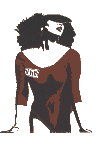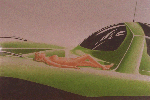The Techniques
Jacob has begun his artistic career by making the triptyque 'The Muscovite Crystal',



in Alphonse Mucha's style, which is characterised by long winding hair and floating ribbons, a well-filled picture, big circles and a black line surrounding the women. His panel consisted of plywood, reinforced by a wooden frame, covered by several layers of paint and then smoothed by sandpaper.
But after this trial Jacob abondoned this late XIXth century Parisian style. A painting, covered with dozens of objects, mathematical shapes and ribbons are too time consuming, so that he lacks the time for the most important object, the woman.
After the 'Crystal', Jacob chose a more modern appraoch. The resut was a series of some twenty plywood panel paintings; at the same size as the 'Crystal' but with less colours and less extras.
He used white alkyd based paint. This is the cheapest paint and he made his own colours by adding pigments.

The background has one even colour and the women have only two or three colours, very often two intensities of the same colour. The goal of this operatin was to create the most powerful image by the most restricted means. Very often he paints just the illimunated side of the body or the shaded side. Nevertheless, the spectator automatically adds what isn't there.
So, at the same time, it was an autodidactic education in understanding the game played by the light and shadows, what he found inevitable before starting any painting filled with degrading colours. Instead of trying to find the cylinders and cubes of which a woman's body is supposed to be constructed, if you believe the educational books on painting,

(AHF)
Jacob researched the light itself.
(Look for the dog in this image below)

(VSR)
It's light and shadow which make an image of a smile an the female form. It is necessary neither to know all the muscles around the mouth, nor to know the three cylinders and two cubes of which a female body is supposed to consist roughly.
Remembring the advice of the sculptor and his elephant, Jacob wanted to draw just what lookes like a woman. If a reflection in the eye is required, then he applies a white spot on the paper. Who cares about the source of light which caused it? Whenever a miniscule spot of light is required you have to draw it. So Jacob doesn't pose questions other than concerning the light and the shadows which appear on the paper. He doesn't draw a belly-button, he copies the shadow he sees and everyone says: "It's a belly-button". He says: "You don't have to think too far. If you think further than the shadows, if you form yourself an idea of what's behind the skin, if you reduce what you see to mathematical forms, the result will be a robot-woman. If you think all the time of the muscles and at every one of the five fingers, you will end up with a hand like a rake.
It isn't the function which is important, neither is it the origin of the image, it's just the image itself that counts."
This doesn't exclude that you must take care of a well-thought composition.
Jacob spends a lot of time on arranging the future contents of his drawing:

Whenever the perspective is important, you'd better calculate everything before putting your pencil onto the paper or your brush onto the canvas. Preparing a drawing with an underlying photo may be very useful in case of a critical composition.

After the series of women on plywood panels, a series of portraits of women followed.

Jacob used 'Berill-Karisma' and 'Bruynzeel', pencils


which are rather soft, but you can't yet call them pastel. They allow to mix the colours and to easily smoothen them out
Despite their caracter of soft pencils, they tend to loose a small particle now and then. This is why Jacob prefers to draw on polypropylene sheets instead of paper. These sheets may be gummed and cleaned easily without leaving traces. The polypropylene is 'satinised' as the material is very smooth without treatement. The artist can work on it like on a sheet of transparent architect paper, except for the attention one has to pay to the sheet's surface. Once the surface is damaged, it is impossible to draw on it any further. But generaly speaking, polypropylene is a very practicle material. On every portrait, Jacob added a small piece of thin gold, what stuck without additional glue and without any problem
After the series of portraits, Jacob wanted to have a task that was more demanding. So, instead of making just the faces, he wanted to draw an entire woman. But what was lacking was a kind of contrast. A woman is feminin when she is alone, but she's even more feminin when she's in the presence of somethink that makes a sharp contrast to her. Jacob thought of modern, mechanical, colourful and cold cars,

airplanes,

ships,

The resut wasn't too bad, really, but the contrast could be even stronger: an animal that couldn't exist, because it's a cartoon character, a woman who floats in space embracing Tin-tin, who is protected by his space-suit,

A woman with a little video-game car, still in its digital appearance.

These aren't just contrasts, these are impossibilities! A woman with an imaginary animal or with a computer generated car. Is there any limit? Perhaps there is, so from time to time Jacob puts his feet back on the ground and draws a lady, all alone, dressed only in roller-skates.

and such an images of a girl isn't less impressing than an image of a girl together with Sylvester

or with Kid Ordinn.

Does a woman needs a contrast or not? There are no theories on this subject. You musn't think too much. You must carry on drawing . Drawing light and shadow. Every-one says: "It's a woman", but what is it, really?
How does Jacob work?
All Jacob's models
Series No 1
Series No 2
Universal Page


















